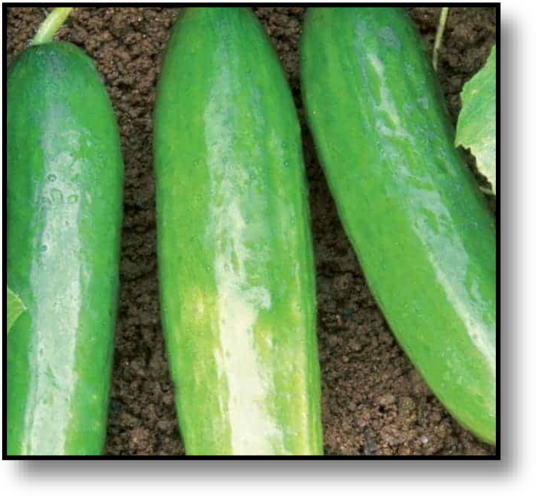





County Fair - 52 days - is a predominantly gynoecious, productive, sweet and crunchy pickler. The 6 - 8 inch fruit are also great for slicing. County Fair was specifically bred by Wisconsin USDA to withstand bacterial wilt. I’ve have grown it with success under lights and in the greenhouse.
Diva - 58 days - was bred by Johnny’s Selected Seeds and won a 2002 AAS award. The fruit is non-bitter with a crisp texture when harvested at 6-8 inches. Mostly seedless, Diva produces all female flowers. The plants have amazing disease resistance and are usually the last vines to succumb to the elements.
Ashley - 65 days — Ashley is an early variety with productive vines and dark green fruit seven to eight inches long, tapered on the stem end. An excellent slicing variety. Released to the public in 1956 by the South Carolina Truck Experimental Station and bred specifically for resistance to downy mildew to perform well in humid climates. An improved ’straight eight.’
Marketmore 76 - 70 days — bred by Dr. Henry M. Munger of Cornell University and released in 1976. The fruits are dark green in color and best harvested for slicing when they are eight to nine inches long. They have a sweet mild flavor and are very disease resistant. Does well in cool climates.
Summer Dance - 55 day - glossy, deep-green, 9” fruits are a Japanese monoecious variety that sends out numerous lateral vines for high yields. Bred by American Takii to be highly resistance to downy and powdery mildew, and tolerant to heat stress. This is my favorite cucumber for crispness and flavor, and a very reliable producer.
July 20. Long awaited first picking of sweet corn.
July 26. Still really enjoying the sweet corn. The garlic leaves are dying back, so it’s time to harvest.
The Hebrews after fleeing Egypt 3500 years ago understandably complained they missed their garlic. Garlic, belonging to the Lily family, contains at least 15 immune-boosting phytochemicals that destroy bacteria, fungi, and viruses directly, and may prevent them from producing toxins. There is also evidence that garlic reduces the risk of cancers in the stomach, colon, bladder, and bowel.
German Extra Hardy, a porcelain hardneck garlic, produces 2 inch bulbs with 4 to 6 cloves. The bulbs have medium heat with a sweet flavor and are easy to peel. As the name implies, this garlic withstands northern winters exceptionally well. They also will store for 6 months. I’ve planted other garlics, but none as reliable and versatile as this one.
Plant hardneck garlic cloves in mid-autumn, softnecks in very early spring.
• Make a furrow 2-4 inches deep
• Leave 5-6 inches between cloves
• Mulch fall plantings with 4” of straw or chopped leaves when ground freezes




